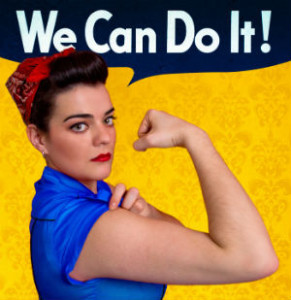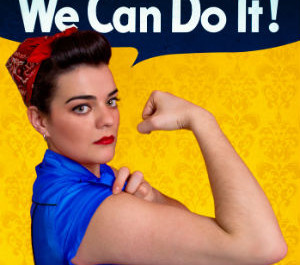Rosie the Riveter
Prior to World War II, most of those employed by the automotive industry were men. However, many men were called away from their jobs and homes to serve in the war. This left the automotive industry, which was so vital to the war effort, severely shorthanded. Women quickly sought employment, serving the war effort at home by quickly and expertly filling these positions. Women took over the operation of riveting guns, drill presses, heavy casting machinery and welding tools. They built B-24 aircraft, tractors and jeeps. They even became test pilots for the B-24s that would be used in the war. Women also filled job positions that were necessary to maintaining order and ensuring the provision of the essentials for daily life.
 “Rosie the Riveter” & The Real “Rosie the Riveter”
“Rosie the Riveter” & The Real “Rosie the Riveter”
The term “Rosie the Riveter” was first used in a song that quickly became a national sensation, performed by big band leader Kay Kyser. In the song, inspired by a woman named Rosalind P. Walter, “Rosie” was an assembly line worker who worked tirelessly to do her part in furthering the war effort. “Rosie the Riveter” quickly became one of the most recognizable icons, representing women who temporarily left their roles as full time mothers and wives to work in industries that had been previously dominated by men.
Over time, the song Rosie the Riveter became closely associated with a woman named Rose Will Monroe. Monroe moved to Ypsilanti, Michigan after having lost her husband in a car accident. Left alone to care for her two young children, she joined the millions of other American women who were working to support their families and help the war effort. She worked at Willow Run Aircraft Factory in Michigan as a riveter, building bombers for the U.S. Air Force.
Because she so closely matched the woman portrayed in the song “Rosie the Riveter,” Rose Will Monroe was given a starring role in a promotional film on the war effort at home. Her image could be found on posters, inspiring women to enter the workforce while the men were away.
After the War
After the war, millions of working women were sent home so that the men could reclaim their prewar jobs. However, women had proven that they were as equally capable and able-bodied as men to perform in previously male-dominated fields. The American workforce was permanently changed, as women made strides to garner the respect and recognition they deserve. The end of the war saw gender added to many nondiscrimination clauses. Over the following decades, laws were put into place, reflecting the changing times.
Though Rose Will Monroe, along with millions of other women, were sent home at the conclusion of the war, her influence on the American workforce was significant and lasting. While in her 50’s, Monroe fulfilled her dream to pilot a plane. The role of women during the war had permanently changed the way America viewed women, and perhaps even how women viewed themselves.







